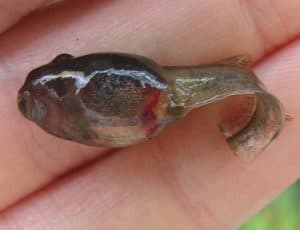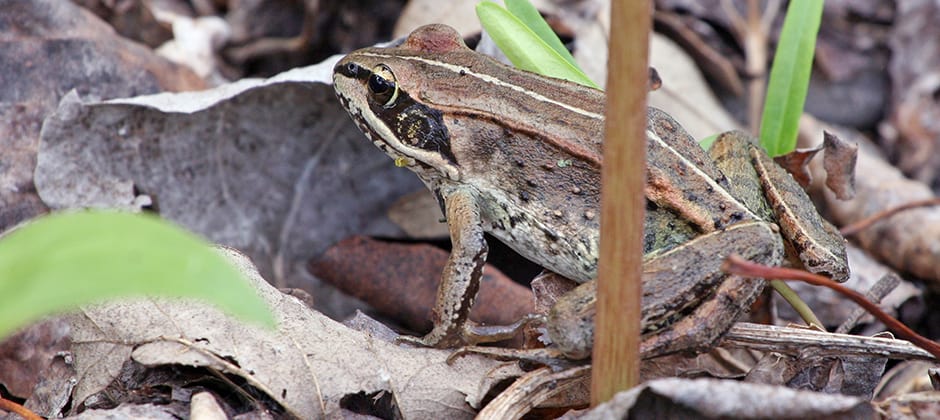Share this article
De-icer may intensify tadpoles’ viral infections
Wood frog tadpoles have more intense ranavirus infections in ponds that have high salinity as a result of being close to roads treated with salt for de-icing.
Emily Hall, a PhD student at Washington State University, was planning to study how road salts were affecting frogs’ development in the northeastern U.S. But during her first field season, all her tadpoles died. After bringing them back to the lab, she found all their deaths were related to ranavirus.
So Hall changed the course of her research. In a study she led published in Proceedings of the Royal Society B, Hall and her colleagues began looking at how pond salinity affected ranavirus infections on wood frogs (Lithobates sylvaticus).
Deadly funguses affecting amphibians — the chytrid fungus affecting frogs and Batrachochytrium salamandrivorans, or Bsal, affecting salamanders — get more attention, leaving ranavirus understudied, said Erica Crespi, an associate professor at Washington State University and the lead principal investigator on the study.
“Ranavirus is kind of ubiquitous in that it affects multiple vertebrate species,” she said.
But in wood frogs, which are abundant across the Northeast, the virus is also abundant. It’s most prevalent in adults, although they’re asymptomatic. “That’s how it persists,” she said. Tadpoles, which are in the most vulnerable metamorphosis phase, are more likely to die from it.

Ranavirus causes red lesions as pictured here in this wood frog tadpole. Credit: Jesse Brunner
In the study, Crespi and her colleagues conducted field observations where they used conductivity to measure the salinity levels of pond water. They compared the ranavirus loads in tadpoles in saltier and less salty ponds.
The team also conducted experiments in the lab and in experimental ponds where they treated water with de-icing salts and measured virus loads and levels of the stress hormone corticosterone in the tadpoles.
The researchers knew from previous studies that increased corticosterone is present in tadpoles when ranavirus infects them, and it suppresses their immune system. “The disease itself is increasing corticosterone, which might play a role in why their immune systems might not handle the disease well in the tadpole stage,” she said. “During that transition, they’re most vulnerable to experiencing pathogens, because their immune systems are being dismantled,” she said.
Crespi and her colleagues found that increased salinity meant 10 times more intense ranavirus infections in wood frog tadpoles. Since the frogs’ cells are geared to take in salt no matter what, it can cause a problem on the cellular level. It’s similar to humans eating too much sushi and retaining water, she said. “They can’t release it homeostatically,” she said. This, she suggests, may cause an altered immune system, leaving them susceptible to the virus.
They also found the tadpoles were shedding more of the virus in saltier ponds.
Using environmental DNA, the team took water samples and measured the amount of ranavirus in the ponds over time. Tadpoles in salty water shed five times as much virus into the water than those in less salty ponds, researchers found, and although they’re not sure if the shed virus is infectious, it raises concerns that it could lead to a higher rate of spread.
Once they started using eDNA, the team found the ranavirus was everywhere. But they believe that increased salinity from nearby roads may be one thing that predisposes the animals to the virus.
Wood frogs are still abundant and widespread, Crespi said, but this research suggests their populations may still be at risk, especially if they face multiple stressors, including a warming climate drying up their ponds.
Meanwhile, Crespi said, managers can think about using other materials to mitigate winter road ice. “I understand that, with the densities of drivers that need to get to work or anywhere else, keeping the roads safe is really important,” she said, but in more rural and suburban area she suggested assessing the use of other tools.
“The amount of salt used is quite a lot,” she said, “[Applying salt] is a knee jerk reaction to play it safe. If you want to consider these effects to wildlife, and if you want to acknowledge this stressor could interact with others to cause more of an effect, it’s worth a conversation about something else that could still be safe and not affect the wildlife around the roads as much.”
Header Image:
Wood frog tadpoles living in salty ponds may be predisposed to intense ranavirus infections.
Credit: Gary Eslinger/USFWS








